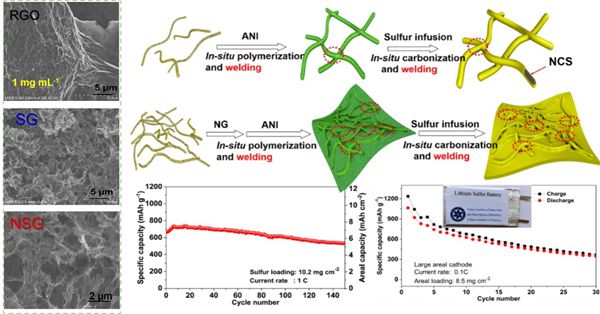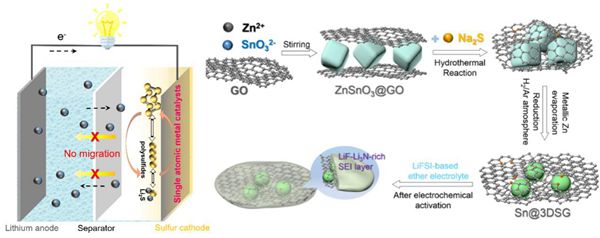With the development of electric vehicles and mobile electronic products, society has put forward higher requirements for energy storage and conversion. Following lithium-ion batteries, high energy density, high rate charge and discharge, and high cycle stability have become requirements for rechargeable batteries. Lithium-sulfur batteries have become a candidate for the next generation of energy storage systems by virtue of their high energy density (2600 Whkg-1), economy and environmental protection. However, problems such as the non-conductivity of elemental sulfur and lithium sulfide, the shuttle effect of lithium polysulfide intermediate products, and the volume change during charging and discharging reduce the utilization rate of lithium-sulfur batteries, causing rapid capacity degradation and hindering their commercialization. The team of Zhang Yuegang and Lin Hongzhen, a researcher at the Suzhou Institute of Nanotechnology and Nano-Bionics, Chinese Academy of Sciences, prepared different active nano-catalyst composite materials from the structure design and surface functionalization of nano-materials, and selected in-situ spectroscopy to study their related mechanisms. Researchers optimized and adjusted the pore structure and functional groups of 3D graphene to achieve strong physical and chemical adsorption of soluble polysulfides (Journal of Power Sources, 2016, 321, 193); using in-situ chemical polymerization Enhance the structural stability of the three-dimensional graphene/carbon nanotube composite nanomaterials, and realize the long-life stable cycle of high-area loading (10.2 mgcm-2) sulfur cathode (Figure 1) (Nano Energy, 2017, 40, 390) . At the same time, studies have found that only relying on physical and chemical adsorption to inhibit the shuttle effect has limitations and cannot meet the rapid charge and discharge characteristics of the battery. In view of this, the research proposes a variety of "adsorption + catalysis" strategies to comprehensively solve the key problems of lithium-sulfur batteries, using a one-step method to synthesize highly active oxygen-deficient metal oxide (ODMO) nanocluster catalysts, experimental and theoretical simulation results It is proved that the oxygen defect active sites can significantly accelerate the breaking and formation of SS bonds in polysulfides, reducing the battery capacity reduction rate to 0.055%, and meeting the requirements of fast charging/discharging and long-term stable performance (ACS Applied Materials & Interfaces, 2020, 12, 12727). In order to reduce the difficulty of removing lithium ions during charging of the non-conductive reaction product lithium sulfide and speed up the electrochemical reaction, research has introduced single-atom catalysis into the field of lithium batteries, combined with spherical aberration correction electron microscopy and synchrotron X-ray absorption spectroscopy (XAS) Confirm the existence of single-atom catalyst. The results show that the single-atom catalyst can significantly improve the charge and discharge rate of the battery based on the conversion reaction. The battery capacity is still 58 8mAh g-1 at 12C (theoretical 5 minutes full charge), and the capacity decay rate is 0.06 at 1000 cycles at 5C. %. The research team also used in-situ XAS to preliminarily study the evolution of monoatomic iron catalysts in the delithiation process (Energy Storage Materials, 2019, 18, 246). In addition, in order to meet the commercial requirements of high-area-load lithium-sulfur batteries, large-capacity batteries need to achieve rapid battery charging and discharging. In order to solve this problem, the researchers prepared a uniformly loaded and distributed single-atom cobalt (SACo) catalyst composite cathode material on the nano-carbon substrate, proving that the single-atom catalyst can accelerate the diffusion rate of lithium ions in the high-area loading Li2S electrode reaction. Lithium batteries that achieve high energy density and power density provide research ideas (Energy Storage Materials, 2020, 28, 375). Based on the above research, the researchers wrote a conceptual article entitled Single-Atomic Catalysts Embedded on Nanocarbon Supports for High Energy Density Lithium-Sulfur Batteries in ChemSusChem (ChemSusChem, 2020, 13, 3404), which outlines the application of carbon in the field of lithium-sulfur batteries in the past two years. The research work of nano-materials supported single-atom catalysts expounds the important role of atomic-level catalysts in catalyzing electrochemical reactions in the battery field and makes a prospect. In addition to the positive electrode, the research team has also made progress in the research of the metal negative electrode. It has been found that choosing a suitable electrolyte can form a solid electrolyte interphase (SEI) on the surface of the Sn electrode, improving the stability and life of the battery (ACS Applied Materials & Interfaces, 2019, 11, 30500). The first author of the relevant research results is Ph.D. Wang Jian, and his research work is supported by the National Key Research and Development Program, the National Natural Science Foundation of China, and the German Alexander von Humboldt Foundation. Ip Camera Pro,Hd Ip Cameras,2.0Mp Hd CCTV Cameras,1080P Hd CCTV Cameras TD Cloud Security Co.Ltd , https://www.cctvcameraexpert.com


